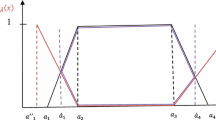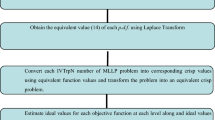Abstract
In real world, there exists determinate and/or indeterminate information. Hence, the indeterminate problems are inevitable and have to be taken into account in optimization problems. Then, a neutrosophic number (NN) is very suitable for expressing determinate and/or indeterminate information because a NN (\(z=a + bI\)) consists of its determinate part a and its indeterminate part bI for \(a,b\in R\), where the symbol “I” denotes indeterminacy and R is all real numbers. This paper firstly presents some basic operations of NNs and a neutrosophic function involving NNs, which is simply called a NN function and then develops a NN linear programming (NNLP) method to handle NN optimization problems. Moreover, a numerical example and an application of production planning are provided, respectively, to show the solving method and application of NNLP problems. In general, the NNLP method yields the basic NN solutions. Further, the possible ranges of the optimal solution are discussed when the indeterminacy I is specified as a possible interval ranges corresponding to actual requirements in real applications.
Similar content being viewed by others
References
Abdel-Baset M, Hezam IM, Smarandache F (2016) Neutrosophic goal programming. Neutrosophic Sets Syst 11:112–118
Ben-Tal A, Nemirovski A (1999) Robust solutions of uncertain linear programs. Oper Res Lett 25(1):1–13
Goberna MA, Jeyakumar V, Li G, Linh N (2016) Radius of robust feasibility formulas for classes of convex programs with uncertain polynomial constraints. Oper Res Lett 44(1):67–73
Jeyakumar V, Li G (2010) Characterizing robust set containments and solutions of uncertain linear programs without qualifications. Oper Res Lett 38(3):188–194
Kong LW, Wu YF, Ye J (2015) Misfire fault diagnosis method of gasoline engines using the cosine similarity measure of neutrosophic numbers. Neutrosophic Sets Syst 8:43–46
Liu BD (2009) Theory and practice of uncertain programming, 2nd edn. Springer, Berlin
Pramanik S (2016) Neutrosophic multi-objective linear programming. Glob J Eng Sci Res Manag 3(8):36–46
Smarandache F (1998) Neutrosophy: neutrosophic probability, set, and logic. American Research Press, Rehoboth
Smarandache F (2013) Introduction to neutrosophic measure, neutrosophic integral, and neutrosophic probability. Sitech & Education Publisher, Craiova
Smarandache F (2014) Introduction to neutrosophic statistics. Sitech & Education Publishing, Craiova
Smarandache F (2015) Neutrosophic precalculus and neutrosophic calculus. Europa-Nova, Brussels
Ye J (2015) Bidirectional projection method for multiple attribute group decision making with neutrosophic numbers. Neural Comput Appl. doi:10.1007/s00521-015-2123-5
Ye J (2016a) Multiple-attribute group decision-making method under a neutrosophic number environment. J Intell Syst 25(3):377–386
Ye J (2016b) Fault diagnoses of steam turbine using the exponential similarity measure of neutrosophic numbers. J Intell Fuzzy Syst 30:1927–1934
Ye J, Yong R, Liang QF, Huang M, Du SG (2016) Neutrosophic functions of the joint roughness coefficient (JRC) and the shear strength: a case study from the pyroclastic rock mass in Shaoxing City, China. Math Probl Eng, Article ID 4825709, 9 pp. doi:10.1155/2016/4825709
Acknowledgements
This paper was supported by the National Natural Science Foundation of China (No. 71471172).
Author information
Authors and Affiliations
Corresponding author
Ethics declarations
Conflict of interest
The author declares that I have no conflict of interest regarding the publication of this paper.
Human and animal rights
This article does not contain any studies with human participants or animals performed by the author.
Additional information
Communicated by V. Loia.
Rights and permissions
About this article
Cite this article
Ye, J. Neutrosophic number linear programming method and its application under neutrosophic number environments. Soft Comput 22, 4639–4646 (2018). https://doi.org/10.1007/s00500-017-2646-z
Published:
Issue Date:
DOI: https://doi.org/10.1007/s00500-017-2646-z




